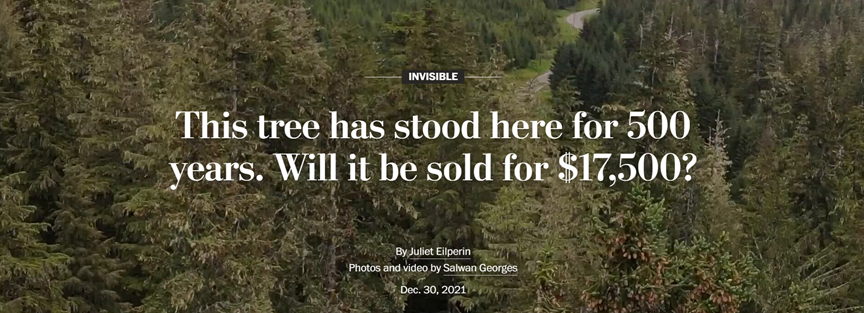A tall tale offers a masterclass in storytelling
Recently, I read an article in the Washington Post that stopped me in my tracks. As a strategic communicator, I’m always analyzing the content I come across, much as an actor watching a movie has an added appreciation for scene blocking and pacing. Eliperin and Georges’ article, "This tree has stood here for 500 years. Will it be sold for $17,500?”, is a remarkable example of strategic storytelling. I know – lots of people talk about the need to tell stories. More people need to talk about how to tell a good story. And, of course, you should tell stories ethically. But let’s dig in on what it means to tell a strategic story.
First and foremost, the story about this majestic tree has a strategic purpose for organizations trying to get people to see the tree as more than board feet for furniture. This story helps us to see the challenges around complex issues like logging and the ways we extract from or protect land. When considering the tree in all its old, wise glory, it’s clear as readers that we could never measure the worth of this tree as solely a commodity for wood.
Andy Goodman talks about having a “sacred bundle” of stories. These are the archetypal stories that your cause will use for different reasons: your origin story, or a story of emblematic success. It comes from indigenous people who have storytelling as a centerpiece of their culture to convey values, lessons and insights. This article focuses on an important archetypal story type, that is indispensable to any cause: the nature of our challenge story. Nature of our challenge stories unpack the issue you’re fighting for or fighting against in a way that gets the listener on your side, and rallies them to say “of course things should not be this way.” The story of this tree does that so effectively, that by the first line you’re hooked. The start of the story says: “This tree has stood here for 500 years. Will it be sold for $17,500?”
This is strategic storytelling at its best. It grabs you right from the beginning. You read about this tree that stands in Alaska, shaped by wind and as tall as a 17-foot building. You start to root for it.
We understand early on that the nature of our challenge is that we are undervaluing this tree when we only see it as board feet. The piece continues to tell us the forest it stands in stores the equivalent of 9.9 billion tons of CO2, something we need stored in greater quantities to avoid the worst effects of climate change. It offers the ingredients needed for a healthy ecosystem that produces plants and berries the Native Alaskans use for food and medicine. It highlights the voice of Marina Anderson, a Native Alaskan from the Haida and Tlingit nations to share the way of life element, amplifying her voice as she shares her perspective.
By telescoping in on this tree, we understand one tree’s value and can then understand the value of a forest. It isn’t as easy to do the other way around. One tree we can see. The forest becomes a blur. It shows us the challenge. When we only consider this tree for one thing: a commodity to use for one thing, we are shortchanging it, and ourselves.
This story has all the hallmarks of great stories: a hero (the tree itself), a history (of the people and the land), a challenge to face with a fork in the road (will the tree be logged?). It uses visual language and actual, compelling visuals to bring you along this journey. And importantly, this story exemplifies systems framing by making shortsightedness, rather than people who work as loggers, the villain.
This offers a fresh angle on what can often be a dead-end narrative of pitting the environment against jobs. By making shortsightedness the true enemy, we can see that we face a common challenge, and can be united in solving it, rather than divided against each other for the profit of a few.
The story offers us a conflict we need to resolve. It says that the tree is marked by blue spray paint. We can see that in our minds—a key component of visual storytelling. This blue mark is a stark reminder: the clock is ticking. Time to decide. In this case we are asked: what is the best use of this tree? And is that with the tree standing, or cut down? The way the story is told lets the reader come to the conclusion, and imagine the scene for themselves. The reader will make up their mind. That is critical.
Strategic storytelling is the most powerful way to engage with audiences on important issues. To use its power to its full extent, start with the basics: know what kind of stories you need to tell. Follow the tips for good storytelling. Make sure your stories reinforce emerging narratives while diminishing tropes and stereotypes, rather than play into dominant narratives that reinforce the status quo. Give listeners the chance to come to the moral of the story on their own. Doing so will create sticky stories that are retold and have the power to motivate change. As a society we have chosen to have this tree remain standing for 500 years. Maybe we should look closer at why this is a good decision.
This entry was posted on Tuesday, April 12, 2022 at 07:49 am and is filed under Ethical and visual storytelling and Frame, narrative and message development. You can follow any responses to this entry through the RSS 2.0 feed. Both comments and pings are currently closed.
